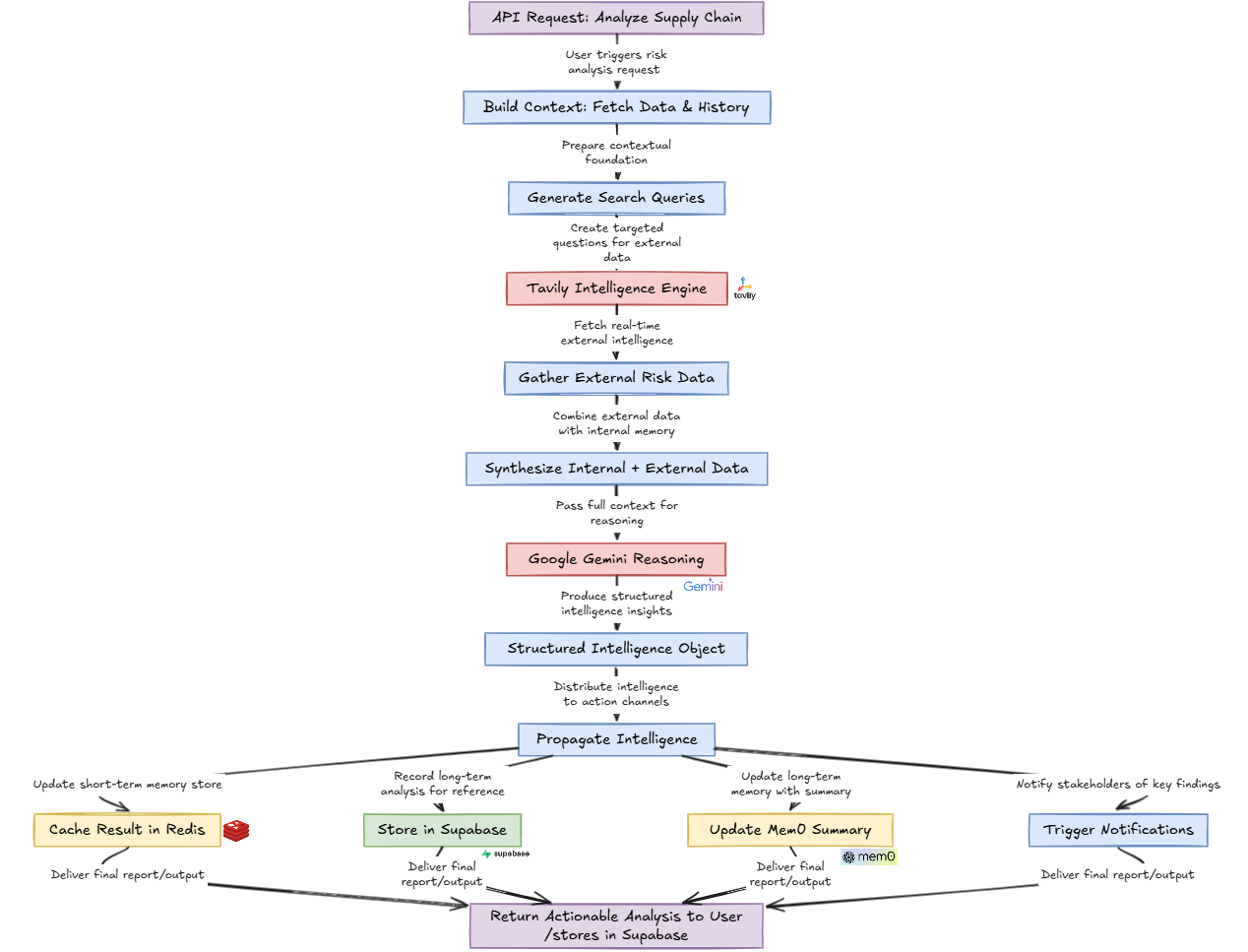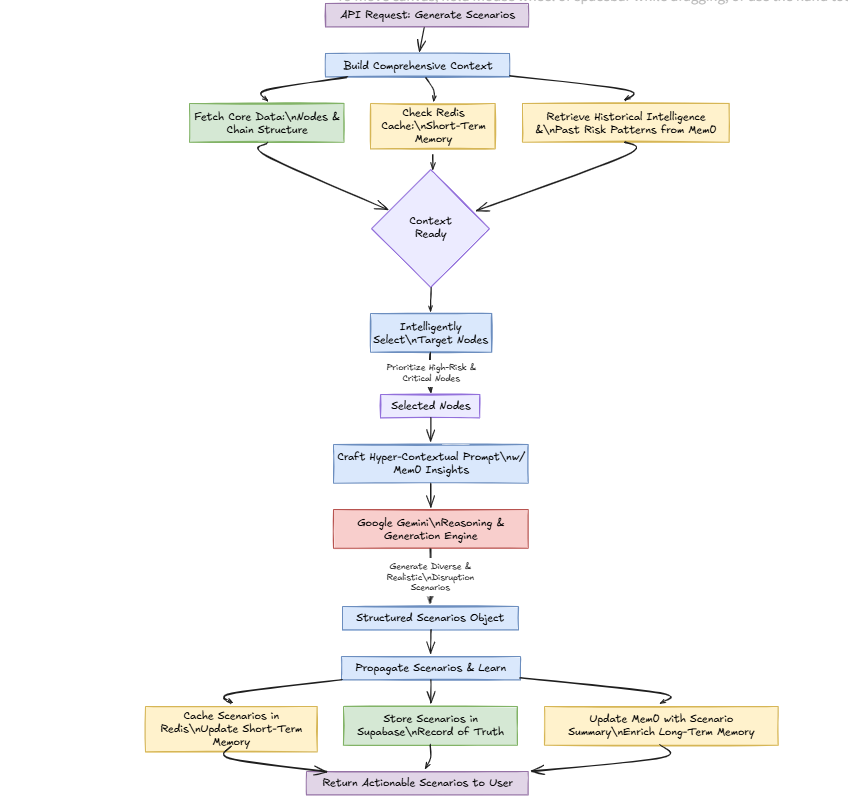IntelliSupply: From Chaos to Clarity with Your AI-Powered Supply Chain Co-pilot
- Published on
- Arnab Mondal--9 min read
Overview
- Let's Dive Deeper: Building Your Digital Twin Inside IntelliSupply
- From "What If" to "What's Next": Proactive Disruption Simulation & Strategy
- Our Digital Front Door: The Landing Page Experience
- 🏆 WE WON FIRST PLACE!
IntelliSupply: Rethinking Supply Chain Resilience with AI and Real-Time Intelligence
In today's business environment, supply chain disruption is no longer an isolated event—it's a persistent and escalating risk. From global pandemics to geopolitical conflicts and climate-driven disasters, the fragility of the networks that deliver raw materials and finished goods has never been more evident. Traditional supply chain management approaches—often reactive and fragmented—struggle to keep pace with this new level of complexity and volatility. A fundamental shift in how businesses manage supply chains is urgently needed.
The financial impact of supply chain disruptions is staggering:
Key Stats:
- Businesses lose an average 6–10% of annual revenue to supply chain issues.
Source: McKinsey, 2021 - Supply chain disruptions caused businesses to miss out on an average of $1.6 trillion in revenue growth opportunity each year, according to Accenture's Resiliency in the Making report
- Nearly two‑thirds (60%) of small and mid‑sized businesses reported revenue losses of up to 15% or more in 2022 due to supply chain delays, per Anvyl's 2023 Supply Chain Outlook survey
Real-World Business Impact:
- Apple: Estimated $6 billion revenue hit in 2020 due to global chip shortages. Source
- Delta Air Lines: Suffered a $550 million loss after a supply chain-driven IT infrastructure failure in 2024. Source
- Global Automotive Sector: Lost $210 billion in 2021 alone from semiconductor shortages. Source
The need for agile, predictive, preventive, and resilient supply chain strategies has never been clearer.
Let's Dive Deeper: Building Your Digital Twin Inside IntelliSupply
IntelliSupply transforms the complex task of mapping a supply chain into an intuitive and conversational experience. Your journey begins with a quick, guided wizard that gathers key details about your industry and operations. Based on your input, the system instantly generates a relevant supply chain template, giving you an intelligent starting point rather than a blank canvas.
From there, our interactive canvas and AI Copilot become your command center. With the ability to perform over 40 distinct actions, the Copilot is your all-in-one tool for building, refining, and analyzing your network. You can instruct the AI with natural language to "optimize the layout" or "add a new factory in Mexico". This conversational approach extends to granular details, allowing you to update node properties, create connections, and even perform bulk changes with a single request. Once your digital twin is built, the Copilot evolves into your analytical partner. You can ask it to "identify single points of failure" or simulate disruptions like, "What happens if our port in Shanghai closes for a week?" to see how risks cascade through your network.
This entire conversational experience is powered by CopilotKit, an open-source framework for building in-app AI copilots. Each of the 40+ commands is defined as a client-side function and exposed to the AI using the useCopilotAction hook. To make the AI context-aware of the supply chain diagram on the canvas, we provide it with real-time data from our application state using the useCopilotReadable hook. This gives the Copilot the "eyes" to see your current work. We then built our own custom chat interface, which renders the AI's responses as Markdown for richer, more readable interactions.
Here's a short video showcasing how it all comes together:
While the frontend provides an intuitive canvas, the true powerhouse of IntelliSupply operates behind the scenes. Our backend is not a monolithic API but a sophisticated, autonomous AI agent designed for proactive intelligence. This agent orchestrates a symphony of cutting-edge tools: it leverages Google's Gemini for complex reasoning, Tavily for its eyes and ears on the real-time web, and Mem0 to provide it with a persistent, long-term memory. The following diagram visualizes the multi-phase workflow our agent executes to transform raw data into a clear, actionable strategy for supply chain resilience.

From "What If" to "What's Next": Proactive Disruption Simulation & Strategy
The true power of IntelliSupply lies in its ability to simulate disruptions and generate actionable strategies, turning "What If" questions into "What's Next" answers. Your digital twin is more than a static map—it's a dynamic, interactive sandbox for building resilience. Instead of waiting for a crisis, IntelliSupply empowers you to get ahead with a powerful suite of simulation and strategy tools. This is where our agentic ecosystem truly comes to life, helping you move from reactive problem-solving to proactive, data-driven preparation.
The journey begins with our Scenario Suggestion Agent. This agent doesn't just look at a snapshot in time; it taps into a long-term, contextual memory powered by Mem0, recalling past risk patterns and recurring vulnerabilities specific to your supply chain. By analyzing the historical intelligence gathered by our Info Agent, it proposes a set of probable, high-impact scenarios—like a potential labor shortage at a key supplier or a looming tariff increase on a critical transport route. Of course, you also have the flexibility to choose from pre-defined templates or design a fully custom simulation, detailing everything from the event's description to the number of Monte Carlo runs.
Once you launch a simulation, our Scenario Analysis Agent takes over. It uses Tavily to pull in real-time data, grounding the hypothetical event in current market conditions and geopolitical realities. The result isn't just a number; it's a multi-faceted impact analysis. You get a clear picture of the potential financial fallout, expected recovery time, and average delays. More importantly, you receive a visual cascading failure map, showing exactly how a single point of failure could ripple through your entire network.
But identifying a problem is only half the battle. With a single click, you can task our Strategy Creator Agent to build a comprehensive mitigation plan. Leveraging Tavily once more, this agent researches industry best practices, regulatory requirements, and proven tactics relevant to the simulated disruption. It delivers a detailed, board-ready strategy complete with timelines, risk-reduction metrics, and key performance indicators. To make execution seamless, you can onboard this strategy, instantly converting it into a structured Kanban board where your team can track progress and turn a plan into action.
The Backend: Our AI-Powered Scenario Generation Agent To move beyond reactive problem-solving, a supply chain manager needs to see the future. Our Production Scenario Agent is engineered to provide exactly that—a window into potential disruptions. This isn't just a random event generator; it's an intelligent system that synthesizes historical data, real-time context, and deep memory to craft highly relevant, probable, and impactful "what-if" scenarios tailored specifically to your supply chain's unique vulnerabilities. The agent's workflow is a masterclass in agentic design. It begins by creating a rich contextual foundation, fetching your supply chain's structural data from Supabase while simultaneously querying its long-term memory via Mem0. This crucial first step allows it to understand not just what your supply chain looks like, but how it has behaved in the past. It recalls historical incidents, past risk patterns, and recurring vulnerabilities. Armed with this deep, memory-enhanced context, the agent intelligently selects the most critical nodes to target—prioritizing high-risk areas or nodes central to your operations. It then crafts a highly detailed prompt for Google's Gemini model, instructing it to generate a diverse set of plausible disruption scenarios. These scenarios are not generic; they are directly informed by the historical patterns retrieved from Mem0, ensuring that the simulated events mirror the real-world risks your supply chain is most likely to face. Finally, the agent closes the loop in a cycle of continuous learning. The newly generated scenarios are cached in Redis for rapid retrieval, persisted in Supabase as a historical record, and, most importantly, a structured summary is sent back to Mem0. This enriches its long-term memory, ensuring that every future analysis is more accurate, more context-aware, and more insightful than the last. Here is a visualization of this sophisticated, multi-phase process:

Our Digital Front Door: The Landing Page Experience
A powerful platform like IntelliSupply deserves a clear and compelling front door. With the hackathon's tight timeline, we designed and built our landing page with speed and clarity as our top priorities. The goal was to create an intuitive experience that quickly communicates our core value proposition. The page guides visitors through our key pillars—Digital Twin Mapping, Disruption Simulation, Impact Assessment, and Smart Strategies—using interactive elements and a central, auto-playing product demo to showcase the platform's power at a glance. It's a clean, modern introduction to the sophisticated agentic system working behind the scenes.
🏆 WE WON FIRST PLACE!
We're thrilled to announce that IntelliSupply won first place at the 100 Agents Hackathon! 🎉
This incredible achievement validates our vision of transforming supply chain management through agentic AI and conversational interfaces. Out of all the innovative projects submitted, IntelliSupply stood out for its sophisticated multi-agent architecture, real-world applicability, and seamless user experience.
🔗 Learn More About Our Journey:
- Official Hackathon Website - Discover the 100 Agents hackathon and other amazing projects
- Our Devpost Submission - Dive deep into our technical implementation and demo videos
- Tavily's Winner Announcement - See the official recognition from our partners at Tavily
This win is just the beginning. IntelliSupply represents the future of supply chain resilience, and we're excited to continue building solutions that help businesses navigate an increasingly complex world with AI-powered intelligence and foresight.